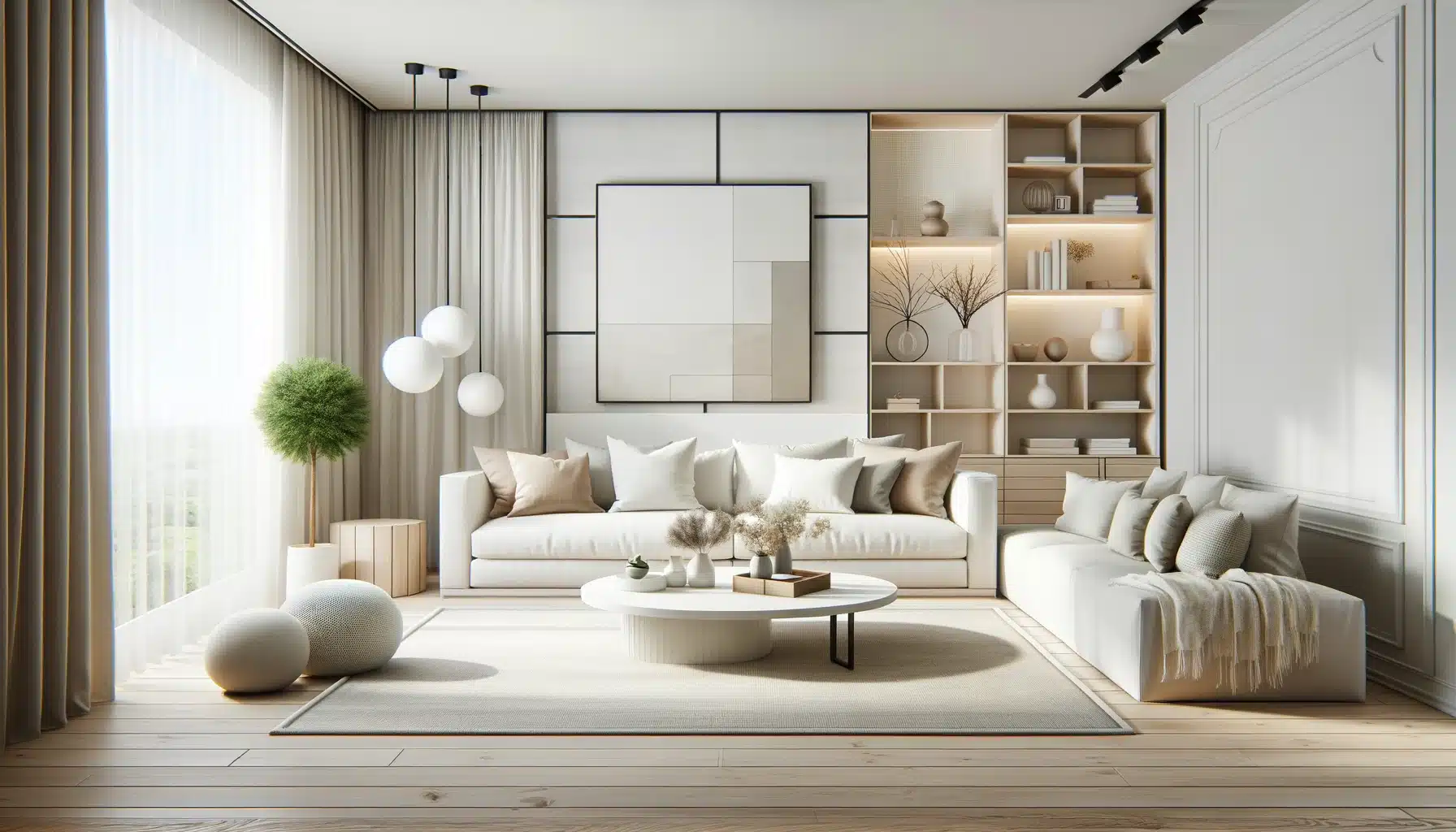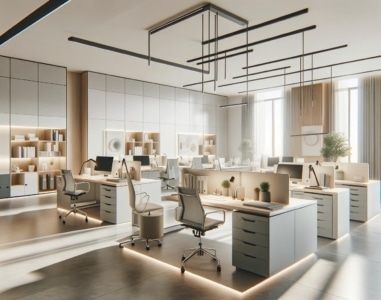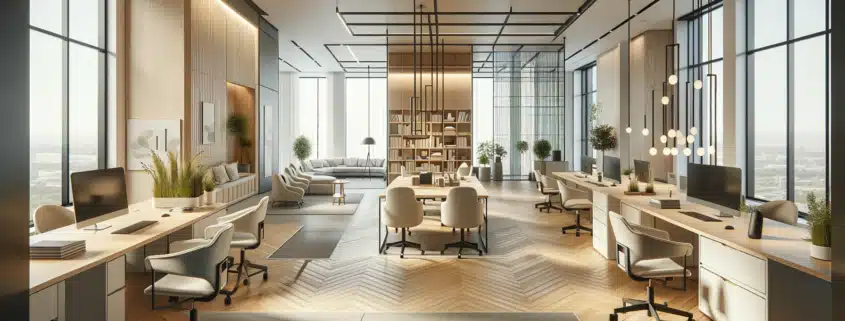The Art of Minimalist Design in Furniture: Harmony of Style and Functionality in Offices and Beyond
Minimalist design, with its emphasis on clean spaces, simple lines and a neutral colour palette, has become a mainstay of modern interior design. This design philosophy goes beyond simple aesthetics, offering an approach to interior design that is as functional as it is elegant.
Principles of Minimalist Design
Minimalist design focuses on essentiality, eliminating the superfluous to enhance space and the objects they contain. Characterised by an open layout, functional furniture and limited use of accessories, this style promotes order and tranquillity in the home or work environment.
Functionality Meets Beauty
In minimalism, every piece of furniture has a purpose and a place. Multifunctional furniture and intelligent storage solutions are key elements, keeping spaces tidy and freeing the room from visual clutter. Functionality is never sacrificed for aesthetics; rather, both blend harmoniously.
Materials and Colours in Minimalist Design
The materials used in minimalist design tend to be natural and of high quality, such as wood, stone and metal. The colour palette is generally composed of neutral tones, which help to create a calming and relaxing atmosphere. However, it is common to use colour accents to add vibrancy and character to spaces.
The Impact of Minimalism on Well-being
In addition to its aesthetic appeal, minimalist design has significant benefits for well-being. Minimalist spaces can reduce stress and promote mental clarity, creating an environment that promotes concentration and relaxation.
Minimalism in the Modern Context
In the modern context, minimalism responds to the growing need for decluttering and a more simplified and conscious life. In an increasingly hectic and overstimulated world, minimalist design offers a haven of peace and serenity.

Application of Minimalism in the Workplace and Public Administration
Minimalism in Office Furniture: Efficiency and Clarity
In the workplace, especially in offices and public administration offices, minimalism offers a distraction-free environment where clarity and order predominate. The adoption of minimalist design in these spaces can mean clean desks, efficient storage spaces and an overall layout that promotes concentration and productivity. Reducing visual clutter helps reduce worker stress, improving focus and efficiency.
Benefits of Minimalism in the Workplace
Among the main benefits of a minimalist work environment are increased productivity and reduced stress. Well-organised and less crowded spaces promote greater concentration, reducing distractions. Furthermore, a minimalist environment can convey an image of professionalism and modernity, which are particularly important for public administration, which wants to project an image of efficiency and accessibility.
Key Points in Adopting Minimalism in the Office
When taking a minimalist approach to furnishing an office, it is important to consider a few key aspects:
- Selection of FurnitureChoose furniture that is both aesthetically pleasing and functional. Furniture with clean lines and simple design can be combined with intelligent storage solutions to keep things tidy.
- Organisation of SpaceGive priority to the openness and fluidity of the space. Avoid clutter and ensure that there is sufficient area for movement.
- LightingMake the most of natural light and integrate lighting solutions that promote a bright and inviting working environment.
- Accenting with Colours: Although minimalism tends to prefer a neutral palette, a strategic use of colour can help define different areas and create a more dynamic and stimulating working environment.
Dealing with the Criticalities of Minimalist Design in the Workplace
 Overcoming Impersonality: One of the most common criticisms of minimalism is that it can make spaces too impersonal or sterile. To remedy this, elements can be incorporated that add warmth and character without compromising the minimalist aesthetic. For example, the use of plants, selected artwork, or colour accents can bring spaces to life while maintaining a sense of order and cleanliness.
Overcoming Impersonality: One of the most common criticisms of minimalism is that it can make spaces too impersonal or sterile. To remedy this, elements can be incorporated that add warmth and character without compromising the minimalist aesthetic. For example, the use of plants, selected artwork, or colour accents can bring spaces to life while maintaining a sense of order and cleanliness.- Stimulating Creativity: An environment that is too bare can sometimes limit creative stimulation. To solve this problem, one can create focal areas or creative corners within the office. These can be spaces dedicated to inspiration, equipped with brainstorming boards, interactive screens or design thinking materials, which encourage collaboration and creativity while maintaining a design consistent with minimalism.
- Balance between Aesthetics and Functionality: It is essential that minimalist design does not sacrifice functionality for aesthetics. This means choosing furniture not only for its appearance but also for its ergonomics and practicality. Furniture must be chosen carefully to ensure that each piece is comfortable and supports the health and well-being of employees. The choice of height adjustable desks, ergonomic chairs and cable management solutions are examples of how minimalism can meet practicality.
- Reflecting Corporate Culture: To ensure that the work environment reflects the organisation's culture and values, it is important to personalise spaces in subtle ways. This can be achieved through the choice of artwork that reflects the company's mission, or through small design accents that speak to the organisation's history and values. It is a matter of finding the right balance between maintaining a clean, minimalist environment while expressing the company's unique identity.
Conclusion
Adopting the art of minimalist design in modern furniture, particularly in the workplace and public administration, paves the way for spaces that not only embody elegance and functionality, but also meet the challenges of a contemporary working environment. Minimalism, when implemented with a focus on customisation, creative stimulation and comfort, can transform offices into places of productivity, well-being and inspiration. Spaces designed in this way not only respect the aesthetic principles of minimalism, but also become tangible expressions of corporate culture and values. In this way, minimalist furniture is not only a design choice, but a true ally in creating work environments that promote balance, efficiency and a sense of belonging.
Views: 0



Leave a Reply
Want to join the discussion?Feel free to contribute!